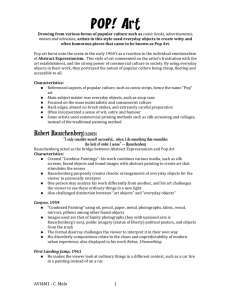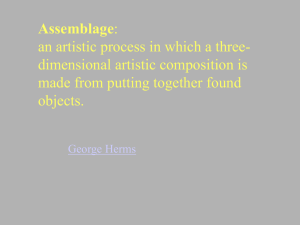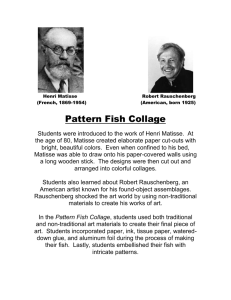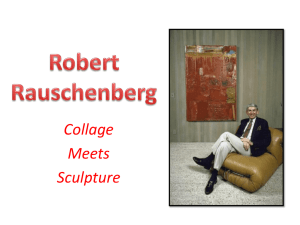Rauschenberg, "Short Circuit" and Hide and Seek
advertisement
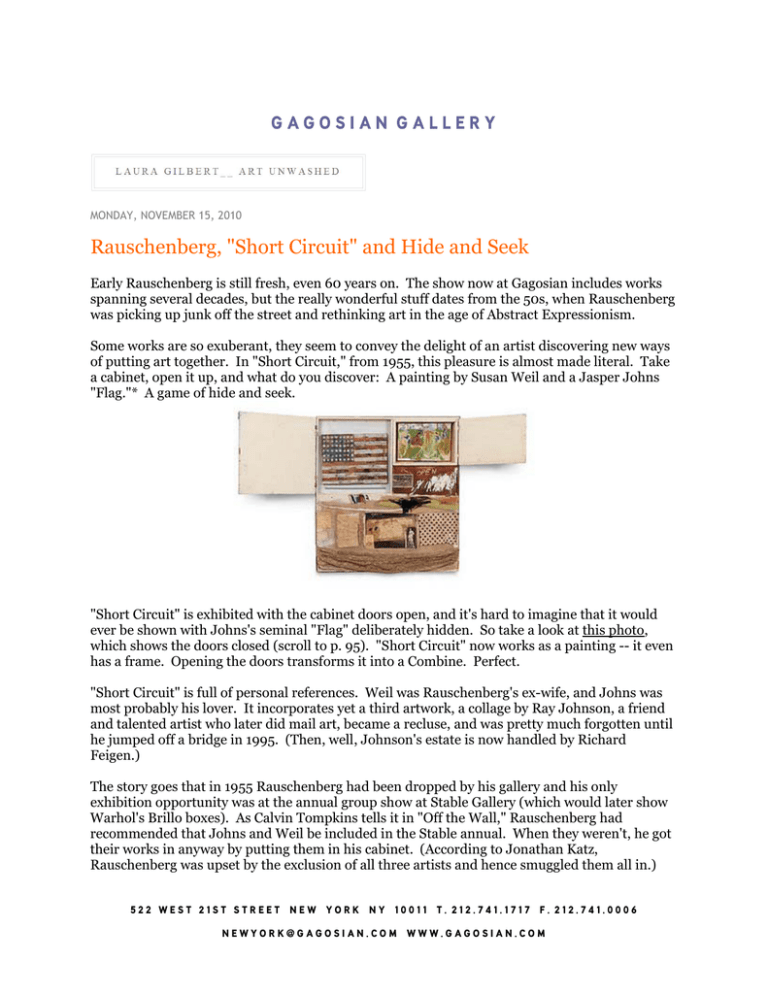
GAGOSIAN GALLERY MONDAY, NOVEMBER 15, 2010 Rauschenberg, "Short Circuit" and Hide and Seek Early Rauschenberg is still fresh, even 60 years on. The show now at Gagosian includes works spanning several decades, but the really wonderful stuff dates from the 50s, when Rauschenberg was picking up junk off the street and rethinking art in the age of Abstract Expressionism. Some works are so exuberant, they seem to convey the delight of an artist discovering new ways of putting art together. In "Short Circuit," from 1955, this pleasure is almost made literal. Take a cabinet, open it up, and what do you discover: A painting by Susan Weil and a Jasper Johns "Flag."* A game of hide and seek. "Short Circuit" is exhibited with the cabinet doors open, and it's hard to imagine that it would ever be shown with Johns's seminal "Flag" deliberately hidden. So take a look at this photo, which shows the doors closed (scroll to p. 95). "Short Circuit" now works as a painting -- it even has a frame. Opening the doors transforms it into a Combine. Perfect. "Short Circuit" is full of personal references. Weil was Rauschenberg's ex-wife, and Johns was most probably his lover. It incorporates yet a third artwork, a collage by Ray Johnson, a friend and talented artist who later did mail art, became a recluse, and was pretty much forgotten until he jumped off a bridge in 1995. (Then, well, Johnson's estate is now handled by Richard Feigen.) The story goes that in 1955 Rauschenberg had been dropped by his gallery and his only exhibition opportunity was at the annual group show at Stable Gallery (which would later show Warhol's Brillo boxes). As Calvin Tompkins tells it in "Off the Wall," Rauschenberg had recommended that Johns and Weil be included in the Stable annual. When they weren't, he got their works in anyway by putting them in his cabinet. (According to Jonathan Katz, Rauschenberg was upset by the exclusion of all three artists and hence smuggled them all in.) 522 WEST 21ST STREET NEW YORK NY 10011 T. 212.741.1717 F. 212.741.0006 NEWYORK@GAGOSIAN.COM WWW.GAGOSIAN.COM GAGOSIAN GALLERY There's also a program of a concert by friend and composer John Cage and an autograph of gay icon Judy Garland. Katz, in "The Art of Code" published in 1993, sees the Garland reference as an allusion "for the first time in Rauschenberg's work to his identification as a gay man" and finds that gay tropes appear in Rauschenberg's Combines with increasing frequency. Katz was quick to note, though, that Rauschenberg never identified himself publicly as gay and that the references may have been intended only as private jokes "to an audience perhaps no larger than his lover" -- i.e., Johns. Another game of hide and seek. As Katz would find out, his suspicion was correct -- Rauschenberg did not intend gay culture references to be read as a statement of identity. In 2004 Katz organized a show at Yale of works that Rauschenberg had given to former lover Terry Van Brunt. Rauschenberg objected. "I am not happy with it," he told the New York Times. "It was organized by the gay studies department, whatever that is. It's not an approach that makes sense. I refused to give them permission to reproduce the works in a catalog." Katz countered that he was not responsible to the artist's wishes, but to the work. Bravo. Unless a piece is commissioned, it's hard to dispute than an artist's personal life will shape the work. At the time of the Yale show, the Hartford Courant reported that Katz was largely shunned by the art world. No more. He's co-curator of the generally favorably reviewed "Hide/Seek" at the National Portait Gallery in Washington, which examines "Sexual difference in the making of American portraiture." (I'm quoting from the NPG's website, as I haven't seen the show.) So "Short Circuit" is an entry point for a lot of interesting questions. It's also a delight for the eyes. Don't miss "Greenhouse" right next to it. Made of soil, wire, nested twigs and broken glass, it's like a Joseph Cornell box set free. Intelligence without pretension, a sense of exploration, an openness to new experience -looking at early Rauschenberg, it seems to be eternally spring. *At some point, the Johns was stolen, and what we now see is a copy painted by Rauschenberg friend Elaine Sturtevant. According to Calvin Tompkins, a dealer once brought in a Johns "Flag" to show Leo Castelli, who immediately recognized it as the painting stolen out of "Short Circuit." The dealer rushed out and "Flag" was never seen again. "Robert Rauschenberg," Gagosian Gallery, 522 West 21st Street, through December 18. 522 WEST 21ST STREET NEW YORK NY 10011 T. 212.741.1717 F. 212.741.0006 NEWYORK@GAGOSIAN.COM WWW.GAGOSIAN.COM
